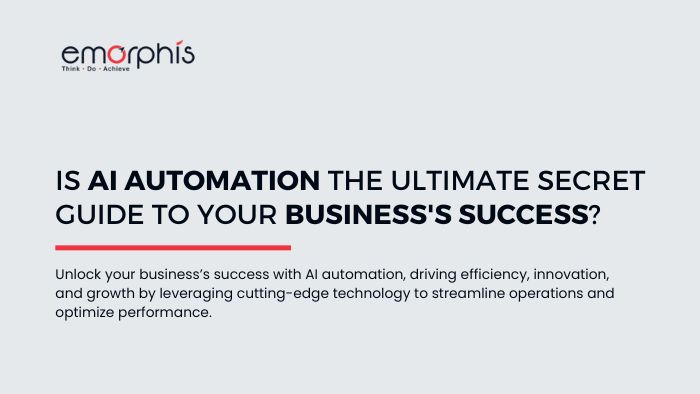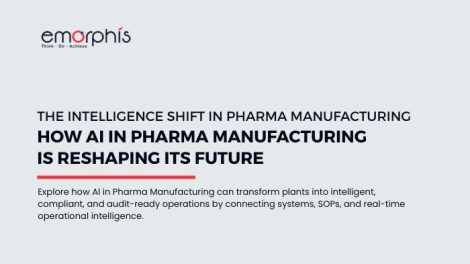Ready to supercharge your business with a dash of futuristic innovation? Imagine your operations running smoother than a well-oiled machine, costs dropping like confetti, and decisions being made with the finesse of a chess grandmaster. Welcome to the world of AI automation, where technology doesn’t just keep up with the pace, it sets it.

Buckle up as we dive into how this game-changing marvel could be the secret ingredient your business needs to not just survive but thrive in the fast lane.
What is AI Automation?
AI Automation is rapidly transforming the business landscape, offering innovative ways to enhance efficiency and drive success. AI automation, in essence, is the integration of artificial intelligence into automation processes to create systems that not only perform tasks automatically but also adapt and improve based on data. The blend of AI and automation isn’t just about speed; it’s about working smarter.
AI automation, moreover, enables businesses to handle complex tasks with greater accuracy, because it leverages machine learning and data analysis to make decisions that would traditionally require human intelligence.
Furthermore, AI automation is revolutionizing industries across the board, from healthcare to manufacturing, and is set to be a key driver of business success in the future.
Statistics Highlighting the Impact of AI Automation
AI automation is making significant waves across industries, with impressive statistics underscoring its benefits.
According to a McKinsey report, 50% of organizations have adopted AI in at least one business function, with 30% utilizing it in multiple areas.
Deloitte’s study reveals that 70% of companies implementing AI automation experienced operational cost reductions, with savings ranging between 10% and 30%.
The productivity gains are remarkable—PwC predicts AI could add up to $15.7 trillion to the global economy by 2030, with businesses seeing productivity boosts of up to 20%.
Additionally, AI automation reduces errors by up to 90% in tasks like data entry. Customer service improvements are evident, with a 30% increase in customer satisfaction scores reported by Forrester.
Revenue growth also benefits, with IBM noting that 41% of organizations using AI have seen increased revenue. The World Economic Forum predicts AI will create 97 million new jobs by 2025, though it will also displace 85 million jobs.
Finally, Capgemini’s report indicates that 72% of organizations see a return on investment within the first year of AI automation implementation.
Data for these statistics is drawn from a range of industry reports and studies, offering a well-rounded perspective on the impact of AI automation on business operations. However, please note that figures may vary depending on the specific context and source, and should be interpreted with consideration of their respective methodologies.

Is AI the Same as Automation?
While AI and automation are closely related, they are not the same. Automation, by itself, is the process of using technology to perform tasks automatically, often following a set of predefined rules. This means that traditional automation can handle repetitive tasks efficiently, but it cannot adapt or learn from the process. AI, on the other hand, involves creating systems that can mimic human intelligence, such as analyzing data, recognizing patterns, and making decisions.
AI has the unique ability to learn from experience and improve over time, something traditional automation can’t match. When AI is integrated with automation, the result is AI automation, a system that not only performs tasks automatically but also does so intelligently, adapting and optimizing based on real-time data.
Technical View of AI Automation
From a technical standpoint, AI automation is built on several key technologies. These technologies include machine learning, natural language processing, and computer vision. Machine learning algorithms enable AI systems to learn from data, enhancing their performance over time.
Natural language processing, moreover, enables AI to understand and generate human language, which is crucial for tasks like customer service automation.
Computer vision, in fact, allows AI to interpret visual data, making it possible for automation systems to handle tasks like quality control in manufacturing. These technologies work together to create AI automation systems that are not only efficient but also highly adaptable.
Furthermore, the integration of AI into automation allows for real-time decision-making and optimization, which is critical for businesses looking to scale and succeed in today’s fast-paced environment.
AI vs. Automation
The distinction between AI and automation is important for understanding how AI automation works. Automation, as mentioned earlier, is about performing tasks automatically based on predefined rules. It is, moreover, highly efficient for repetitive tasks that require consistency and speed.
However, automation lacks the ability to adapt or learn from the tasks it performs. AI, on the other hand, brings adaptability and intelligence to the table. AI systems, in fact, can analyze data, recognize patterns, and make decisions based on that data.
When combined with automation, AI enhances the system’s ability to handle complex and dynamic tasks. AI automation, therefore, represents the next evolution of automation, where tasks are not only performed automatically but also intelligently and adaptively. This combination of AI and automation, moreover, is what makes AI automation such a powerful tool for businesses.
Common Challenges Businesses Face for Success
- Scalability Issues: Businesses often face difficulties in scaling operations efficiently because manual processes are time-consuming and prone to errors. As a business grows, maintaining quality and consistency while managing increased workloads becomes increasingly complex.
- Data Management: Managing large volumes of data presents significant challenges because traditional methods cannot analyze and derive insights from data in real-time. Businesses need robust solutions to handle data effectively and make informed decisions.
- Resource Allocation: Effective resource allocation is crucial yet challenging because businesses must balance cost, efficiency, and quality. Proper allocation of resources ensures that all aspects of the business are adequately supported without wastage.
- Customer Expectations: Meeting rising customer expectations is increasingly difficult because consumers demand personalized and timely service. Businesses need to find ways to deliver high-quality service at scale to maintain customer satisfaction.
- Operational Efficiency: Maintaining operational efficiency is a constant challenge because businesses must continuously optimize processes to stay competitive. Inefficiencies in operations can lead to increased costs and reduced competitiveness.
Benefits of AI Automation
- Enhanced Efficiency: By automating repetitive and time-consuming tasks, AI helps businesses streamline operations and boost overall efficiency. This results in quicker processing times and allows employees to concentrate on higher-value tasks.
- Cost Savings: AI automation can reduce operational costs by minimizing the need for manual labor and lowering the likelihood of costly errors. This financial benefit can be substantial, especially for large-scale operations.
- Improved Accuracy: AI systems are designed to handle complex data analysis with high precision, reducing the chances of human error and improving the reliability of results.
- Greater Flexibility: AI automation enables businesses to quickly adapt to changing conditions or scale operations efficiently, which is crucial for maintaining a competitive edge in dynamic markets.
- 24/7 Operation: Unlike human workers, AI systems can operate continuously, providing consistent performance and availability, which is essential for global and high-demand operations.
- Enhanced Customer Insights: By analyzing customer data, AI automation helps businesses gain deeper insights into customer behavior and preferences, allowing for more targeted marketing and improved customer service.
- Streamlined Workflow: AI helps eliminate process bottlenecks and inefficiencies, leading to smoother and more streamlined workflows.
- Reduced Human Error: AI systems reduce the risk of mistakes associated with manual processes, which can enhance the quality and reliability of outputs.
AI automation not only enhances operational efficiency and accuracy but also provides significant cost savings, flexibility, and valuable insights, making it an important aspect of modern business strategy.

Ultimate Guide for AI Automation
1. Identify Business Needs
The first step in implementing AI automation is to clearly identify your business needs and pain points. Start by analyzing the areas where automation could bring the most benefit. This involves understanding which processes are repetitive, time-consuming, or prone to error.
Engage with various departments to gather insights on their challenges and requirements. By pinpointing specific problems, you can tailor AI solutions to address these issues effectively. For instance, if customer service is a bottleneck, consider AI-powered chatbots to streamline and improve response times.
2. Choose the Right AI Tools
Once you have a clear understanding of your needs, the next step is to select the appropriate AI tools and platforms. Evaluate different AI solutions based on their functionality, scalability, and integration capabilities. Consider factors like usability, support, and cost.
Look for tools that align with your business objectives and can be seamlessly integrated into your existing systems. For example, if your goal is to enhance data analysis, choose AI tools with strong data processing and analytics capabilities. Additionally, seek out tools with a track record of reliability and positive user reviews.
3. Implement Gradually
Implementing AI automation should be a gradual process to ensure a smooth transition and minimize disruptions. Start with small-scale pilot projects to test the effectiveness of AI solutions before rolling them out more broadly. This approach allows you to evaluate the performance of the AI tools, identify any issues, and make necessary adjustments.
Gradual implementation also helps manage risk and provides valuable insights into how the AI automation system performs in real-world scenarios. Once the pilot projects demonstrate success, you can scale up the automation efforts across different departments or functions.
4. Train Your Team
Proper training is crucial for the successful adoption of AI automation. Provide comprehensive training to your team to ensure they are well-equipped to work with the new AI tools. This training should cover how to use the AI systems effectively, interpret results, and integrate the tools into daily workflows.
Additionally, offer support and resources to help employees adapt to the changes. Training not only enhances the efficiency of AI systems but also helps in overcoming resistance to change and ensures that your team can fully leverage the benefits of AI automation.
5. Monitor and Optimize
After implementing AI automation, continuous monitoring and optimization are essential to maintain system performance and effectiveness. Regularly review the performance of AI tools and analyze key metrics to assess their impact on business processes.
Collect feedback from users and stakeholders to pinpoint areas for improvement. Use this information to make necessary adjustments and optimize the AI systems for better results. Ongoing optimization helps ensure that the AI automation remains aligned with business goals and adapts to any changes in requirements or environments.
6. Evaluate ROI
Assessing the return on investment (ROI) of AI automation is an important step to understanding its value and impact on your business. Measure improvements in productivity, cost savings, and overall performance to determine the effectiveness of the AI tools.
Compare the results against the initial goals and expectations to evaluate whether the AI automation has delivered the desired outcomes. Analyzing ROI helps in making informed decisions about future investments in AI and provides insights into the benefits gained from the automation efforts.
By following these steps, businesses can effectively implement AI automation, optimize its performance, and achieve substantial benefits. The ultimate guide for AI automation ensures a strategic approach to adopting this transformative technology, leading to enhanced efficiency, cost savings, and overall business success.

AI Automation Use Cases in Known Industries
AI automation is revolutionizing various industries by enhancing efficiency, improving accuracy, and driving innovation. Here’s a closer look at how AI automation is being utilized across different sectors:
1. Healthcare
In the healthcare sector, AI automation is making great strides in enhancing patient care and operational efficiency. One prominent use case is in diagnostic imaging. AI algorithms are employed to analyze medical images, such as X-rays and MRIs, with high accuracy. This automation helps in detecting anomalies and diseases at an early stage, providing radiologists with valuable insights and reducing diagnostic errors.
Predictive analytics is another key application. AI systems analyze patient data to predict potential health issues before they arise. For instance, AI can predict the likelihood of readmissions or identify patients at risk for chronic conditions. This predictive capability allows healthcare providers to implement preventive measures and personalize treatment plans, improving patient outcomes.
Administrative tasks also benefit from AI automation. Routine tasks such as scheduling appointments, managing patient records, and processing claims can be automated, reducing the administrative burden on healthcare staff. This leads to more efficient operations and allows healthcare professionals to focus on patient care.
2. Retail
In the retail sector, AI automation is transforming how businesses manage inventory, enhance customer experiences, and optimize supply chains. Inventory management is streamlined with AI-driven tools that predict stock levels based on historical data, seasonal trends, and sales forecasts. This helps retailers maintain optimal inventory levels, reduce stockouts, and minimize excess inventory.
Personalized recommendations are another notable application. AI systems analyze customer behavior, preferences, and purchase history to deliver tailored product recommendations. This personalization enhances the shopping experience and drives sales by presenting customers with relevant products they are more likely to buy.
Customer service automation also plays a crucial role. AI-powered chatbots and virtual assistants handle customer inquiries, process returns, and provide support, ensuring 24/7 service. These systems can manage high volumes of interactions simultaneously, improving response times and customer satisfaction.
3. Finance
In the finance industry, AI automation is used to enhance security, streamline operations, and improve decision-making. Fraud detection is a critical use case where AI systems analyze transaction patterns to identify unusual activities that may indicate fraudulent behavior. This real-time monitoring helps prevent financial fraud and protect sensitive information.
Risk assessment is another area where AI automation is applied. AI algorithms evaluate financial data, market trends, and economic indicators to assess and forecast financial risks. This helps financial institutions make informed investment decisions and manage risk exposure more effectively.
Customer service in finance benefits from AI as well. AI-driven chatbots and virtual assistants handle customer queries, provide account information, and offer financial advice. This automation improves efficiency and ensures customers receive timely assistance.
4. Manufacturing
In manufacturing, AI automation is driving advancements in production efficiency, quality control, and predictive maintenance. Quality control is enhanced with AI-powered computer vision systems that inspect products for defects during the manufacturing process. This automation ensures high-quality standards and reduces the likelihood of defective products reaching customers.
Predictive maintenance is another significant application. AI systems analyze equipment data to predict when machinery is likely to fail or require maintenance. This proactive strategy helps minimize downtime, lower maintenance costs, and extend equipment life.
Supply chain optimization is also improved with AI automation. AI tools analyze supply chain data to forecast demand, optimize inventory levels, and streamline logistics. This leads to more efficient supply chain operations and reduced operational costs.
5. Customer Service
In the customer service industry, AI automation enhances the efficiency and effectiveness of support operations. AI-powered chatbots handle a wide range of customer interactions, from answering FAQs to processing service requests. These chatbots can manage multiple interactions simultaneously, providing quick and accurate responses.
Sentiment analysis is another application where AI analyzes customer feedback, reviews, and social media mentions to gauge customer sentiment. This analysis enables businesses to gauge customer satisfaction and spot areas for improvement.
Automated ticketing systems can manage and prioritize customer support requests. AI systems can categorize and route tickets based on their content, ensuring that high-priority issues are addressed promptly and efficiently.
By leveraging AI automation in these industries, businesses can enhance operational efficiency, improve customer experiences, and drive innovation. The applications of AI automation are vast and varied, demonstrating its potential to transform different sectors and contribute to overall business success.
How Much Does AI Automation Really Cost?
The cost of AI automation can vary widely depending on the scope, complexity, and industry application. Key factors include the initial investment in AI tools, the cost of data acquisition and processing, and the integration of AI systems with existing infrastructure. Moreover, there are continuous costs for maintenance, updates, and staff training to ensure the effective use of AI-powered systems.
For small to medium-sized businesses, costs might range from tens of thousands to hundreds of thousands of dollars, while larger enterprises could see investments reaching into the millions. However, the long-term return on investment (ROI) often outweighs the initial costs, with AI automation driving significant efficiency gains, reducing operational costs, and unlocking new revenue streams.
Further, click on the link to read details on Enterprise AI Solutions Enhancing Business Operations with Artificial Intelligence.
Automate Responsibly
When implementing AI automation, it is crucial to approach the process with responsibility and ethical considerations. First and foremost, ensuring ethical practices is essential. Businesses must respect privacy and adhere to data protection regulations to maintain trust and integrity.
Additionally, while AI systems can handle many tasks autonomously, maintaining human oversight is important. Human intervention remains necessary to monitor AI systems, address potential issues, and ensure that the technology is functioning as intended.
Furthermore, addressing bias in AI is critical. Bias in AI algorithms can lead to unfair outcomes and impact decision-making processes negatively, so actively identifying and mitigating biases is essential. Providing ongoing training and support to employees who work with AI automation also plays a significant role. This ensures that staff are ready to adapt to new technologies and effectively utilize AI tools.
Finally, conducting regular audits of AI systems helps maintain their reliability and effectiveness. Regular reviews ensure that AI automation systems continue to meet performance standards and operate correctly.
By following these practices, businesses can leverage AI automation’s benefits while upholding ethical standards and achieving operational excellence.

Conclusion
In conclusion, AI automation is a game-changer for businesses, driving productivity, reducing costs, and improving decision-making. By integrating AI and automation, companies can tackle scaling challenges, unlock new opportunities, and enjoy significant benefits.
As AI technology advances, adopting it responsibly will position businesses for long-term success. For expert guidance and customized AI software development solutions, connect with Emorphis.
Our team is here to help you harness the power of AI automation to enhance your business capabilities and drive future growth.







